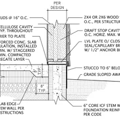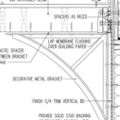Insulating vaulted ceiling
I am building a tiny house / cabin and have 2×6 joists my current plan is to use 1/2″ osb on the deck covered with synthetic underpayment then a radiant barrier on top of that follower by 2×4’s strips to gain 1.5″ of air space then attach my metal roofing to that. On the underside I was going to do closed cell spray foam for a sealed roof the. T&G pine over the insulation are there any faults with this plan? I read in a article I should install drywall with a vapor retarding paint then the T&G over then any reason why? Also plan on installing a lunos e2 HRV.
GBA Detail Library
A collection of one thousand construction details organized by climate and house part










Replies
Devin,
Where are you located?
Northern WV on the border of zones 4A and 5A.
Devin,
The maximum amount of closed-cell spray foam that can be installed between 2x6 joists is about 5 inches. (Because cured closed-cell spray foam is very hard to trim, installers won't fill the entire framing bay.) That means that you'll have a maximum R-value of R-30 -- which is OK, but less than the code minimum of R-49.
Q. "I read in a article I should install drywall with a vapor retarding paint, then the T&G over that. Any reason why?"
A. If you had chosen a different type of insulation -- for example, fiberglass batts -- you would need an interior air barrier. (Since tongue-and-groove boards do not create an air barrier, ceilings insulated with fiberglass need taped drywall as an air barrier.) The advice doesn't apply in your case, since closed-cell spray foam is an air barrier.
That said, there is still the issue of fire safety. Most codes require spray foam to be covered with a thermal barrier (defined as gypsum drywall with a minimum thickness of 1/2 inch) for fire safety. Your local code authority may not consider tongue-and-groove boards to be an acceptable thermal barrier, so before you proceed with your plan, check with your local building department or code official.
Thanks Martin
Another question should I use the synthetic underpayment or something like some 15lb felt to let the sheathing breath into the air space. Also I only have about 3" overhangs on the sides of the roof should I use some ice and water shield?